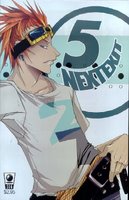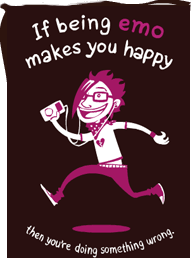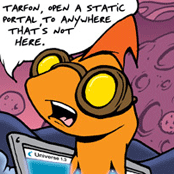
So, I was skulking around my local comic store, Minotaur ,on Thursday and I picked up a trade paperback copy of the first volume of Stray Bullets and the trade paperback copy of Next Exit. Minotaur is a large pop-culture/comic store in central Melbourne. As I was going through them, I was luxuriating in the finality of a collected work.
I’d already collected all the single issues of Next Exit and as I read the first volume I could see the master plan emerge. The first six issues were always intended as a thematic whole as a graphic novel instead of disparate parts. I could now put the story together it is a whole. Yet when I look online all I usually see are gag strips and even the longer narratives are disconnected and formulated around jokes.
I think the medium of the internet is against the webcomic functioning as the equivalent of a graphic novel. A single issue comic that is collated later into a graphic novel has a length that allows a thematic unity; in opposition to this the webcomic is usually punctuated by the necessity of daily or weekly updates. In order to get to the stage of a graphic novel, it’d a slow trawl through the story and thus ‘slice of life’ comics prevail because the webcomic is if nothing else an immediate artform.
Even longer narratives such as Something Positive are usually constructed around a joke at the end of each strip. The medium that supports the webcomic makes it far harder to create graphic novels. Webcomic viewers want instant gratification; each strip has to make sense on its own. If you don’t like it you can just skip to the next webcomic, hurry, hurry along. So, a webcomic doesn’t have the luxury of a continuous narrative that is encapsulated even in a single issue print comic. The demands of an online audience creates narratives broken up into updates or snippets of narration.
Thus, a comic like Fell wouldn’t work online because of its slow-burning narrative. Things can build up where a webcomic usually is required to possess a thematic whole with each strip, it can’t afford not to be. This retards overall narration. Stray Bullets online would result in outraged noobs on the forum asking for the punch line, it’s an interrelated narrative and that works better in printed collected work, not in an archive of disconnected strips in a webcomic.
If you do try and buck the trend you get accused of overextending yourself, the clearest culprit in webcomic critical circles is Megatokyo. Perhaps Megatokyo isn’t a good example because as the Webcomic examiner stated in their roundtable on the history of webcomics, it’s a print comic that’s found itself online. The complaints that ensued when Rodney Caston was edged out were indicative of an audience that preferred gaming gags to long term continuity.
Even a webcomic stalwart such as Sluggy Freelance is lop-sided because of the continual need for jokes to keep the audience reeled in. Abrams only attempts emotional complexity in the adventure sequences such as Fire and Rain and more recently in the technically brilliant Wayang Kulit storyline. It seems outside of fantasy sub-plots, characters in SF are not allowed to fully express their emotions. This makes reading through the archives a distorted reading experience as normalcy comes back after what should be moving forward.
I’ve seen and purchased the print editions of Megatokyo at Minotaur, I’ve also seen print versions Penny Arcade and Sinfest there. The move of the more successful webcomics to print versions was perhaps inevitable. PVP and Megatokyo are the most popular, there are smaller variants of this, Sam and Fuzzy has printed up some of its strips but only on pre-order and not in a more thematic whole in the way ScaryGoRound presents its archives.
I’m pretty sure most print versions of webcomics are peripheral to the main enterprise, usually purchased by the converted as an add-on. Print versions of webcomics, with the exception of Megatokyo, aren’t graphic novels, they are collections of individual strips, as already stated, they could hardly be otherwise given the internet’s ferociously fast attention span. They are a way of adding physical form to what you love and are far easier to read that to trawl through years of archives.
Yeah, okay, nothing beats the thrill of looking for comics online but I think the printed versions are usually a luxury reserved for the more successful webcomics and will continue as such, there might be a crossover into print comics but nobody I know in the comic stores even knows about webcomics. That’s not to say they’re inferior, I wouldn’t be reading webcomics and writing this blog if they were, webcomics have weaknesses compared to print comics but the strengths outweigh them.
Webcomics are more fluid and energetic than the majority of print comics. The top of the field in print comics is supposedly Marvel and DC’s superhero wankery; the top of the field within webcomics is far more exciting artistically and supports far more interesting work.
Quality usually prevails because in order to survive or move up to being funded by your artwork you have to attract more people. There’s no company funding you, it’s fully freelance. The biosphere in webcomics is far more complex and forums force together a sense of community that you rarely see in print. The webcomic creator talks to (rants at) you via messages each update, (e.g. Sore Thumbs and Questionable Content). Yeah, I get a thrill from both print and webcomics but only webcomics gives me that rush as I check each day for a new update.
 Stuff sucks has 'it', this fantastical Amsterdam inhabited by English speaking ex pats is a weird place. The 'it' is the whole sluttish mix of different characters. If the artwork somewhat resembles Return to Sender, then the narrative is a free-flowing haze of emotion and japery. (Though Zemi is like a skankalicious version of Colette) I like the looseness here and the willingness to explore sub-plots. It's also what the strip doesn't do that makes it stand out. Liz Greenfield could have added in the goldfish as a talking mascot goldfish but she didn't, she showed restraint.
Stuff sucks has 'it', this fantastical Amsterdam inhabited by English speaking ex pats is a weird place. The 'it' is the whole sluttish mix of different characters. If the artwork somewhat resembles Return to Sender, then the narrative is a free-flowing haze of emotion and japery. (Though Zemi is like a skankalicious version of Colette) I like the looseness here and the willingness to explore sub-plots. It's also what the strip doesn't do that makes it stand out. Liz Greenfield could have added in the goldfish as a talking mascot goldfish but she didn't, she showed restraint.

